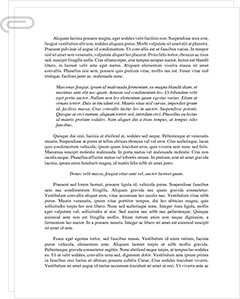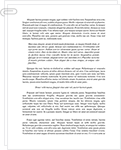 Study Document
Study Document
International Trade and Finance Speech: Good Afternoon Essay
Pages:3 (1005 words)
Sources:3
Subject:Government
Topic:International Trade
Document Type:Essay
Document:#76052362
International Trade and Finance Speech:
Good afternoon ladies and gentlemen, I would like to share with you on the current state of the U.S. macro-economy, highlighting the internal and external factors that affect it. Macroeconomic analysis seeks to forecast economic conditions by monitoring and gauging the behavior of several broad areas including gross domestic product (GDP) - which is simply national output, the rate of unemployment, and the state of currency inflation.
According to the U.S. Department of Energy's Energy Information Administration (EIA), America tops the list of the world's largest oil consumers with a consumption rate of 18.8 million barrels per day (MBD). Concurrently, the U.S. ranks third in the worlds list of top oil producers at 9.1 MBD. The 9.7 MBD shortfall between U.S. oil production and consumption is the main contributor to country's trade deficit (Smith, 2011).
Foreign oil dependence means America's business and consumer trends are vulnerable to world oil prices. The U.S. economy depends heavily on freight transportation, which runs on gasoline, to link businesses, suppliers, and consumer markets throughout America and the world. An upward world oil price spike exerts a drag on the economy as the energy costs inherent in manufacturing and supply chain transportation rise proportionately. Higher product prices lead to lower consumer spending and negatively affect the economy.
International trade bears direct influence on America's GDP as economists consider the quantity of goods and services in imports and exports in their calculations. Since our imports generate income abroad, they are subtracted from the other categories of domestic spending to get a clearer picture of exactly how much the economy produces. Consequently, a trade surplus leads to a larger GDP, while a trade deficit leads to a contracted GDP. International trade brings a greater variety of products and services into the domestic market. This benefits American consumers by spurring greater quality in products and services at the best prices.
However, while America's goods trade deficit is huge, it enjoys a large service trade surplus. Approximately 47% of this service trade surplus is attributed to professional service businesses that make up the bulk of America's emergent knowledge-based economy. Such businesses offer professional services like advertising, computer software, financial services, medical and health care services, research and development services, recruitment services, software engineers, and web designers (White, 2010). To strengthen this knowledge-based economy the government offers incentives in the form of two tax credits, the lifetime learning credit and the American opportunity credit. This helps university and college students offset the costs of higher education by reducing their income tax.
While international trade opens up the domestic market to imported goods and services, it can also threaten local jobs and industries by delivering products at prices much cheaper than local companies can afford to deliver them at. In such instances, it's the role of the U.S. government to protect local industry by the judicious imposition of tariffs or quotas to specific goods or services. Tariffs come in the form of an extra tax levied according to…
Sample Source(s) Used
References:
Morrison, W.M. (2011, September 30). China-U.S. Trade Issues. Retrieved March 10, 2012, from http://www.fas.org/sgp/crs/row/RL33536.pdf
Smith, C.H. (2011, February 28). We're no. 1 (and No. 3)! Surprising Facts About the U.S. And Oil. Retrieved March 10, 2012, from http://www.dailyfinance.com/2011/02/28/surprising-facts-about-us-and-oil/
White, D.S. (2010, August 14). Growth of the Knowledge-based Economy: U.S. Service Exports January - June 2010. Retrieved March 10, 2012, from http://dstevenwhite.com/2010/08/14/growth-of-the-knowledge-based-economy-u-s-service-exports-january-june-2010/
Related Documents
 Study Document
Study Document
Ethics Needed in the US Counterintelligence Community
HOW EARLY EFFORTSAT DEVELOPINGA COUNTERINTELLIGENCEPROGRAMINTHE 1950s AND 1960s INFLUENCED CURRENT USCOUNTERINTELLIGENCE POLICIESA Master ThesisSubmitted to the FacultyofAmerican Public University SystembyAlexgardo OrriolaIn Partial Fulfillment of theRequirement for the DegreeofMaster of ArtsAugust 2020American Public University SystemCharles Town, WVviTheauthorhereby grantsthe American PublicUniversity System the right todisplay these contentsfor educational purposes.Theauthorassumestotalresponsibility formeetingthe requirementsset by UnitedStates copyrightlawfor the inclusionofany materialsthatare not the author�screation or in the public domain.� Copyright2020by Alexgardo OrriolaAll rights reserved.DEDICATIONI dedicate thisthesisto
 Study Document
Study Document
The Need for Virtue Ethics in the Counterintelligence Community
CI FinalAbstractThis thesis describes the need for an ethical standard in counterintelligence (CI) so as to facilitate collaboration among the various CI agencies and the private sector. It conducts an analysis of the formation of the counterintelligence program under Angleton, the use of CI within the Federal Bureau of Narcotics under Anslinger, and the use of CI in the Phoenix Program and the FBI�s COINTELPRO. This analysis is used to
 Study Document
Study Document
Management Seminar Demonstrate a Basic Understanding of
Management Seminar Demonstrate a basic understanding of the terminology, history and theories of business and management principles. Although the concept of management is already a few centuries old, the basis for the development of a science of management was laid during the Industrial Revolution. Until the 1960's diverse viewpoints on management were recognized leading to the development of a more integrated approach to management. The process approach emphasized the basic functions of



